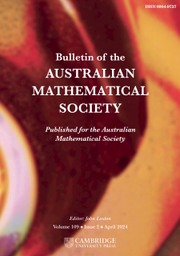Article contents
ON THE BURES METRIC,  $C^*$-NORM AND QUANTUM METRIC
$C^*$-NORM AND QUANTUM METRIC
Published online by Cambridge University Press: 27 January 2025
Abstract
Given a unital  $C^*$-algebra and a faithful trace, we prove that the topology on the associated density space induced by the
$C^*$-algebra and a faithful trace, we prove that the topology on the associated density space induced by the  $C^*$-norm is finer than the Bures metric topology. We also provide an example when this containment is strict. Next, we provide a metric on the density space induced by a quantum metric in the sense of Rieffel and prove that the induced topology is the same as the topology induced by the Bures metric and
$C^*$-norm is finer than the Bures metric topology. We also provide an example when this containment is strict. Next, we provide a metric on the density space induced by a quantum metric in the sense of Rieffel and prove that the induced topology is the same as the topology induced by the Bures metric and  $C^*$-norm when the
$C^*$-norm when the  $C^*$-algebra is assumed to be finite dimensional. Finally, we provide an example where the Bures metric and induced quantum metric are not metric equivalent. Thus, we provide a bridge between these aspects of quantum information theory and noncommutative metric geometry.
$C^*$-algebra is assumed to be finite dimensional. Finally, we provide an example where the Bures metric and induced quantum metric are not metric equivalent. Thus, we provide a bridge between these aspects of quantum information theory and noncommutative metric geometry.
Keywords
MSC classification
Information
- Type
- Research Article
- Information
- Bulletin of the Australian Mathematical Society , Volume 112 , Issue 2 , October 2025 , pp. 355 - 365
- Copyright
- © The Author(s), 2025. Published by Cambridge University Press on behalf of Australian Mathematical Publishing Association Inc.
Footnotes
This work is partially supported by the first author’s NSF grant DMS-2316892. The third author was partially supported by the Research Council of Norway (RCN), project no. 345433.
This article has been updated since its original publication. A notice detailing this can be found here: https://doi.org/10.1017/S0004972725100737.
References
A correction has been issued for this article:
- 1
- Cited by
Linked content
Please note a has been issued for this article.


